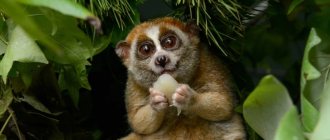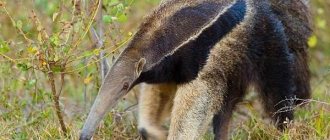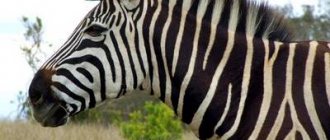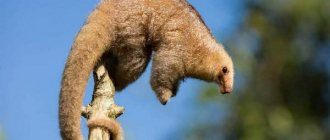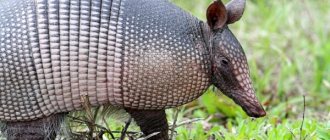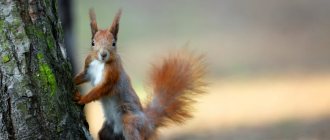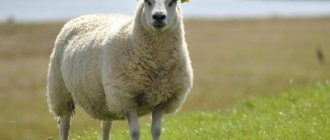The family Lemuridae contains both common, widespread and very rare species. Some lemurs are widely known to scientists and the general public, while others have been poorly studied. In this article we will talk about the smallest representatives of the family - mouse and dwarf lemurs, which, due to their timidity and secretive lifestyle, are difficult to study.
Mouse and dwarf lemurs are the smallest primates in Madagascar. They live throughout the island, including rainforests in the east, dry deciduous forests in the west, and thorny forests in the south.
Description of dwarf lemurs
All living dwarf lemurs have well preserved some primitive features, making such mammals one of the best living evidence of our origins. However, such inhabitants of the tropics of Madagascar are almost completely different from any monkeys well known and studied by people today.
Appearance
Dwarf lemurs are animals with long tails and characteristic, very well developed, bulging eyes . The head of the dwarf lemur is shortened, with a rounded muzzle. The hind legs are slightly longer than the forelimbs, but all the fingers of such a mammal are equally well developed and are characterized by the presence of tenacious and sharp claws. The medium-sized ears are covered on the outside with sparse and very thin, numerous hairs.
The fur of small animals is soft, and in some areas it has a pronounced silkiness. The fur on the back is wavy and quite delicate. Dwarf lemurs that inhabit the tropical forest areas of Madagascar are distinguished by red fur with a brownish tint. All animals living in the dry forests of western Madagascar have predominantly gray fur on the back.
This is interesting! The smallest dwarf mouse lemurs today are the smallest, and the average weight of an adult of this species is just over 28-30 grams.
The eye color of a primate directly depends on the species, but most often the mammal has orange-red or brown-yellow eyes. Among the thirty species, mouse lemurs are the most famous, since today such animals are most often purchased by connoisseurs of exotic pets as pets.
Character and lifestyle
All representatives of the family Dwarf lemurs belong to nocturnal animals, showing activity exclusively when it gets dark, which is the reason for their large eyes, which can see perfectly at night thanks to special reflective crystals. During the daytime, such mammals sleep, characteristically curling up into a ball. For sleeping or resting, mostly tree hollows and comfortable nests made with grass, small branches and leaves are used.
In zoological parks, dwarf lemurs, along with other nocturnal animals, are kept in special conditions or halls called “Nocturnal Primates.” During daylight hours, sufficient darkness is artificially maintained in such rooms, which allows any nocturnal animals to feel comfortable and maintain natural activity. At night, on the contrary, the lights turn on, so the lemurs go to sleep.
All representatives of the relatively large family can rightfully be classified as unique animals among the known primates . This opinion is easily explained by the ability of animals to spend long periods of time in a state of torpor or suspended animation.
During this period, there is a slowdown in metabolism and a noticeable decrease in body temperature, due to which the animal saves a large amount of energy. Fork-banded lemurs, which never hibernate, nest in tree hollows, and sleep and rest exclusively in a characteristic sitting position, with their heads lowered between their forelimbs.
This is interesting! The lemur's vocal range is represented by various sounds through which such primates can communicate with each other, and some sounds can propagate at the ultrasonic level.
With the onset of the warm season, at the stage of preparation for hibernation, dwarf lemurs begin active feeding, which increases the weight of the animal by about a couple of times. Fat reserves accumulate at the tail base, after which they are gradually consumed by the lemur’s body during the period of suspended animation. In natural conditions, dwarf lemurs prefer to stay alone or can unite in pairs. They move very deftly by jumping or running along branches in tree crowns, using all four limbs for this purpose.
How long do lemurs live?
There is variation among lemurs in overall lifespan. For example, Cockerel's mouse lemurs in nature live for about twenty years, and representatives of the species Gray mouse lemurs in captivity live up to fifteen years or even a little more.
Return to content
Interesting Facts
- Residents of Madagascar, the Malagasy, have long believed that lemurs are the souls of their dead ancestors, so in some villages residents even bring them special fruit offerings.
- But another funny Malagasy superstition did not benefit the lemurs: it is believed that the dried index finger of a lemur can restore... lost male potency. Therefore, sometimes lemurs became the subject of hunting by elderly Malagasy people who wanted to again feel like 19-year-old boys in amorous affairs.
- Malagasy people have a special superstitious fear of the lemur. According to the islanders, any person who kills a little hand will die within a year. Scientists still do not know what the locals call the little hand, since they never say its name out loud.
- The vocal range of lemurs has 12 different sounds. With their help, these animals communicate with each other, and what’s interesting is that some of these sounds sound at the ultrasound level.
Species of dwarf lemurs
Today, the family of dwarf lemurs includes five genera, and is also represented by three dozen species, among which the most common are the following:
- Fat-tailed dwarf lemurs (Cheirogaleus medius) - have a body length in the range of 6.0-6.1 cm with a tail length of 13.5-13.6 cm and a body weight of 30.5-30.6 g;
- Large dwarf lemurs (Cheirogaleus major) - characterized by a rather short tail, with a noticeable thickening at the base;
- Cockerel's mouse lemurs (Mirza coquereli) - differ in body length with a head ranging from 18-20 cm with a tail no more than 32-33 cm and a maximum body weight of 280-300 g;
- Dwarf mouse lemurs (Microcebus myохinus) are one of the smallest primates with a body weight of 43-55 g and a length of 20-22 cm;
- Gray mouse lemurs (Microsebus murinus) are one of the largest representatives of the genus and weigh between 58-67 g;
- Rufous mouse lemurs (Microsebus rufus) - characterized by a weight of about 50 g with a body length of 12.0-12.5 cm and a tail of 11.0-11.5 cm;
- Bertha's mouse lemurs (Microcebus berthae) are endemic to the island state of Madagascar and are currently the smallest primates known to science with a body length of 9.0-9.5 cm and an adult weight of 24-37 g;
- Hair-eared lemurs (Allosebus trichotis) - have a length of up to 28-30 cm with an average weight of no more than 80-100 g;
- Fork-banded lemurs (Phaner furcifer) have a body length of 25-27 cm and a tail length of 30-38 cm.
This is interesting! In 2012, a new species was discovered in the eastern part of the Sahafina forest, located 50 km from the Mantadia national park area - the Herpa mouse lemur or Microcebus gerpi.
The genus Cheirogaleus or Rat lemurs includes six species, and the genus Microcebus or Mouse lemurs is represented by two dozen different species. The genus Mirza is considered to be the smallest today.
Return to content
Who are lorises
Loris are cute nocturnal predatory mammals from the Loridae family. Their large, close-set eyes see well in the dark, and their tiny ears catch the chirping of the wings of an unwary insect against the background of the noise of the jungle. They do not have a tail, but they have a unique toilet comb located on the wrist. Animals use it to tidy up their fur when they wash themselves.
THIS IS INTERESTING. Contrary to the popular name, lorises are not lemurs. These are two different families that are united only by the order Primates.
Javan slow loris in its natural habitat
There are two genera of animals: thin (Loris) and thick (Nycticebus) lorises. The first include the red (Ceylon) and gray lorises living in the tropics of South India and the island of Sri Lanka. The locals call both of them Tewangu. The second genus lives in the humid forests of Southeast Asia and includes 5 species: Bengal, slow, Kalimantan, Java and small.
THIS IS INTERESTING. The phrase “fat, aka slow, aka small loris” is often used. It appears due to the fact that all “fat women” are similar to each other in appearance, lifestyle and behavior. And in English-language literature, instead of “fat” they are all called slow.
The funny names of the groups are due to the characteristic body structure. Slender lorises are smaller and more graceful than their more massive, densely built relatives. Even the smallest species, the Kalimantan slow loris, has an average body length of 24 cm, while for the “skinny” loris this is a rarely reached maximum. But the fat ones are far from the long, slender legs of their thin relatives.
A thin red lory crawls along a branch
Area, distribution
Cheirogaleus medius are distributed in the western and southern parts of Madagascar, where they inhabit dry and moist deciduous tropical forests, preferring the lower tier of vegetation. The species Cheirogaleus major lives in forested and wooded arid areas in the east and north of Madagascar, and is sometimes found in west-central Madagascar.
Woolly-eared dwarf lemurs (Cheirogaleus crossleyi) inhabit the northern and eastern forests of Madagascar, while Sibri's dwarf lemurs (Cheirogaleus sibreei) are common only in the east of the island state. Representatives of the Mirza coquereli species have chosen the arid forests of Western Madagascar. Discovered by Kappeler only in 2005, the Great Northern Mouse Lemur is an animal common in the north of Madagascar.
Microcebus myoxinus is an inhabitant of the arid mixed and deciduous forests of the island state and Kirindy Nature Park, and the natural habitats of the species Microcebus rufus are secondary and primary forests, including forest belts in tropical coastal zones and secondary bamboo forest areas.
Return to content
Possible diseases
You can determine a pet’s illness by its behavior - if the animal behaves lethargically, constantly sleeps and its appetite has worsened, it is better to consult a veterinarian.
While in captivity, a lemur can contract the following diseases:
- colds, since they strongly depend on the temperature;
- diseases of the gastrointestinal tract, poisoning;
- allergic reactions to food;
- periodontal disease.
Diet of dwarf lemurs
Almost omnivorous representatives of the family Dwarf lemurs eat not only fruits and bark, but also flowers and nectar, being active pollinators of many plants. Some species are characterized by a short-term descent to the ground, which allows them to hunt for all kinds of insects, as well as quite small animals, including spiders and small birds, frogs and chameleons.
This is interesting! The amount of vegetation is not always sufficient to feed the animals, so to replenish their strength, lemurs take long rests or slow down their physical activity.
Among other things, primate mammals often indulge themselves by licking the juices of various plants using their relatively long tongue. The teeth of the dwarf lemur have a special structure, therefore they are perfectly adapted for easy cutting of tree bark, which stimulates the active flow of plant nutritional juices.
Return to content
Purchase
Where to buy and what to look for
There are four ways to buy a pet: at a pet store, from someone else, at a nursery, or through an advertisement. But in the case of a lemur, only one of them is possible - buying from breeders, since it is unlikely that you will find this animal in a regular pet store.
This is due to the fact that the removal of these primates from their habitats for subsequent sale is prohibited and is considered poaching. Therefore, when purchasing, you need to make sure that your animal was born and raised in a nursery, and was not kidnapped from its usual environment. If you are offered to buy an animal second-hand and without documents, it was most likely brought into the country illegally.
It is also necessary to check the veterinary passport, vaccinations, documents confirming the origin of the animal.
Price
It’s better to ask yourself how much a domestic lemur costs in advance. The price depends on the type of animal, as well as your place of residence, and can vary from 40,000 to infinity. So, a loris lemur can cost about 50-70 thousand rubles, but a feline lemur will cost in the range of 150-300 thousand. A dwarf lemur can be bought for 70-80 thousand rubles.
The price is also affected by the presence or absence of vaccinations, the age and gender of the animal (males cost more). If the price of the animal is too low, then it is quite possible that it entered the country illegally.
Reproduction and offspring
Active rut in different species of representatives of the family Dwarf lemurs is confined strictly to a certain type of season, and the mating behavior of most of these primate mammals is represented by loud screams and touching their partner. For example, the breeding season for the fat-tailed dwarf lemur is October. Relationships in a family can be either monogamous or polygamous . As a rule, the female bears offspring annually, but the total duration of pregnancy varies greatly among representatives of different species.
After about a couple of months of pregnancy, the female gives birth to two or three fairly well-developed cubs. Pregnancy in large dwarf lemurs lasts just over two months, and the offspring that are born are fed with mother's milk for 45-60 days. The Mirza coquereli species bears its young for about three months, after which one to four young are born. The weight of a newborn dwarf lemur is only 3.0-5.0 grams. Babies are born completely blind, but very quickly open their eyes.
After birth, the cubs hang on their mother’s belly, clinging to the female’s fur with their limbs, but adults are able to independently carry their offspring in their mouths. Most often, at the age of one month, dwarf lemur cubs can easily and quickly climb plants or trees, but at first they tirelessly follow their mother.
Important! As soon as the mammal is weaned from breastfeeding, it immediately acquires complete independence.
Primate mammals reach sexual maturity at one and a half or two years, but even at this age the animal maintains close contact with its parent, so it makes itself known to the mother with loud cries. During the seasonal breeding season, species identity is easily determined by the vocal data of partners, which effectively prevents the process of hybridization between different species that have significant external similarities.
Return to content
How do these animals communicate?
Lemurs produce a fairly wide range of sounds, the frequency of which is about 10-36 kHz. Scientists who analyzed the vocalization features of dwarf lemurs revealed a lot of interesting things. Thus, by the cry of the animals, each individual can be identified. Research has shown that neighboring lemur communities communicate in different dialects.
During the breeding season, males produce characteristic vibrating sounds consisting of musical phrases. They are very reminiscent of birdsong. The frequency of their repetition depends on the degree of interest of the females and on the motivation of the male himself.
Natural enemies
Even despite their sufficient natural agility and spending most of their time under the protection of the tree crown, representatives of the family Dwarf lemurs very often become easy prey for numerous predators.
The main enemies of such lemurs in their natural habitat are represented by the Madagascar long-eared owl and barn owls, as well as large hawks and civets, some snakes, including the tree boa.
Dwarf lemurs can also be hunted by some predatory mammals, including narrow-striped and ring-tailed mungos, as well as fossas, which are typical endemic representatives belonging to the family of Madagascar civets. Quite often, representatives of the family Dwarf lemurs are attacked by mongooses or adult domestic dogs of large breeds.
According to statistics, every year about 25% of mouse lemurs die as a result of attacks by various predatory animals. However, according to long-term observations, even significant losses in the general population can be restored very quickly due to the active process of reproduction of such primate mammals.
Return to content
Nutrition
Vary lemurs feed on food of plant origin. Up to 90% of their diet consists of fruits that are high in fat and non-structural hydrocarbons.
They eat fruits, flowers, flower nectar and young leaves of more than 130 plant species, mainly from the Burseraceae, Myrtaceae, Lauraceae, Tilioideae and Moraceae families.
During pregnancy and nursing, females in the late afternoon show a clear preference for eating flowers and young leaves, which contain more protein compared to other food. This is necessary to improve the quality of breast milk.
Black-and-white varmints most often pick fruits hanging from the thin ends of the branches. To reach them, the primate hangs upside down, clinging to branches with its hind limbs. This agility allows it to compete with smaller and lighter lemurs.
Sometimes the animal comes down to the ground to eat some mushrooms and soil. This way he manages to replenish the lack of useful minerals in the body and get rid of some intestinal parasites. In search of food, it covers a distance of 400 to 2200 m every day.
Population and species status
Today, absolutely all species of lemurs have been assigned protected status, and a significant part of these rare primates are classified as endangered species. Representatives of some species, in particular, hair-eared lemurs, are currently classified as endangered species.
This is due to the active deforestation of native forests and the mass destruction of adult individuals for the purpose of use as food, as well as capture for further sale as popular and exotic pets. People are attracted by the small size of the animal and its expressive eyes, but when kept in captivity, such primates need to be provided with conditions that are as close as possible to the natural environment.
Return to content
Keeping at home
Sometimes lovers of exotic pets get a pet lemur. And why not, many species of lemurs (but not all) are easily tamed by humans, they are not aggressive and docile. But before you get yourself such a Madagascar pet, you need to know the nuances of caring for a lemur, and how to feed it correctly.
It is very important that the cage or terrarium in which the lemur will live is spacious; you must place tree branches there and hang artificial vines on which the pet will climb, remembering its native Madagascar forests. The bottom of the cage should contain sawdust; they will have to be changed periodically, since it will not be possible to train a lemur to a tray. If you don’t clean it regularly, then both the cage and the lemur itself will soon begin to smell very bad, you know what. Also, there should always be a bowl of drinking water in the cage so that the lemur can quench his thirst at any time.
Although lemurs are protected by fur, nevertheless, being heat-loving animals, they do not tolerate drafts well, so the cage with the lemur should be in a place protected from drafts.
Endemic
This article is about endemism in the biological sense. For the general idea, see Endemicity; about this in folkloristics, see Endemic (folkloristics). Endemics, or endemics (pronounced; from the Greek ??????? “local”) - a specific component of some flora or fauna. Endemics include species, genera, families or other taxa of animals and plants, the representatives of which live in a relatively limited area, represented by a small geographical area. Endemic species of plants and animals, due to their limited range and, consequently, limited numbers, are often listed in the Red Books as rare or endangered species. Oceanic islands, isolated mountain valleys and reservoirs isolated from other reservoirs with similar biotic collections are especially rich in endemic forms. In particular, in the flora on the island of Saint Helena, about 85% of species are endemic, and in the Galapagos Islands - up to 97%. In the fauna and flora of Lake Baikal, up to 75% are endemic.

